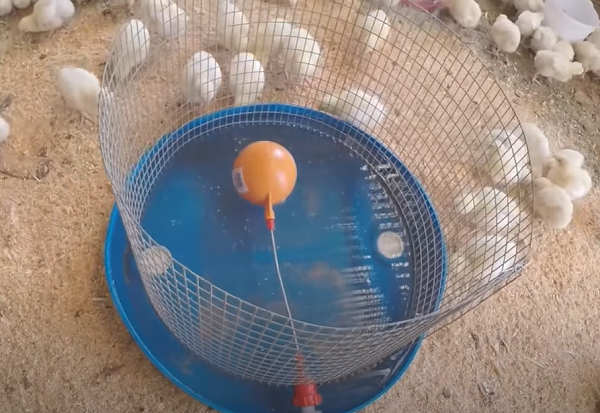How to make a Functional Chicken Drinker
How to make a Functional Chicken Drinker – Once again I started this project with an idea but was not sure how it’s going to end or even if it was going to work. I found a couple of obstacles when I build the gravity fed waterer but figured out quickly how to make the system work 100% Before I tell you about How to make a Cheap Watering System for Chickens, let take a look at Bell Drinkers.
Buying Bell Drinkers and Drinking holders for a chicken farming business is very costly. Once you bought a Bell Drinker you still need to do fitting and buy piping for your layout from your main water supply into your coops. Couplings, clamps, control valves and many more nominal expenses needs to be purchased before you can start feeding water to your chickens. Planing thoroughly is always a good measure before you start installing your water system.
The watering system I build was cheap and I mainly used recycle materials. I only had to buy a valve that was around R 80 or $5

How to make a Functional Chicken Drinker
My first challenges was to make sure that the system works for both day old chicks all the way to fully grown chickens. Solving this problem I raised my day old chicks bedding to 150 mm of sawdust and gently squeezed the water drinker about 100 mm into the sawdust. This works well and the day old chick could enjoy fresh water whenever the needed to.
The second challenge was to keep the day old chicks as well as the almost grown chicks out of the water to keep it fresh and clean. What I have done was to take the radius of the base and subtracted 40 mm and made a wire mesh ring that fit perfect into the water drinker. I made it about 600 mm high so that the day old and younger chickens could not jump over. I am not concerned about the bigger broiler trying to jump in as they are to heavy to jump.
This watering system now works well for day old up to fully grown chickens. I also made a bigger scale drinker for my pigs on the same system and only clean the waterer once a week with and then spray it down with Virukill to avoid any bacteria growing in or on the base.
The system was made to be connected to a 1000 litre water tank that is about 40 meters outside of the chicken coop and is elevated to roughly 2 meters. That ensure a decent gravity flow for the water and means that we one less job to worry about.
In this video you can see how I build the gravity fed water drinker and how the chickens enjoy having fresh water all the time.
Making a homemade chicken drinker can be a relatively simple project. Here’s a basic guide to help you create a functional and effective chicken drinker:
Materials You’ll Need:
- Large plastic container with a lid (e.g., a clean 5-gallon bucket)
- Chicken waterer cups or nipples (available at farm supply stores or online)
- PVC pipe or flexible tubing (for connecting the cups/nipples)
- Drill with appropriate drill bits
- Silicone sealant or plumber’s tape (if needed for sealing connections)
Steps to Make the Chicken Drinker
- Prepare the Container:
- Make sure the container is clean and free of any contaminants. If using a bucket, ensure it’s food-grade plastic.
- Drill a hole near the bottom of the container for the PVC pipe or tubing to pass through. The hole should be just large enough to fit the pipe or tubing snugly.
- Install Chicken Waterer Cups or Nipples:
- Decide whether you want to use waterer cups or nipples. Waterer cups are small cups with a valve that releases water when chickens peck at them. Nipples are small valves that release water when chickens press on them.
- Follow the manufacturer’s instructions to install the chosen cups or nipples into the container. This usually involves drilling holes in the container and securing the cups/nipples in place.
- Connect the PVC Pipe or Tubing:
- Depending on the design of your container and the cups/nipples you’re using, you’ll need to connect the cups/nipples to the container using PVC pipe or flexible tubing.
- Cut the PVC pipe or tubing to the desired length, considering the height of your chickens. The pipe/tubing should connect the cups/nipples to the container securely.
- Attach the pipe or tubing to the cups/nipples, and then pass the other end through the hole you drilled in the container.
- Seal Connections (if necessary):
- Use silicone sealant or plumber’s tape to create watertight connections between the PVC pipe or tubing and the cups/nipples, as well as around the hole in the container.
- Fill and Test:
- Fill the container with clean water and secure the lid.
- Allow the chickens to investigate and learn how to use the drinker. They should quickly learn to peck at the cups or nipples to release water.
- Regular Maintenance:
- Regularly clean and refill the container to ensure a clean water supply for your chickens.
- Check for leaks and any signs of wear and tear, and make repairs as needed.
Advantages of a Chicken Waterer
Using a dedicated chicken waterer offers several advantages compared to alternative methods of providing water to your chickens. Here are some key benefits:
- Clean Water Supply: Chicken waterers are designed to keep the water clean and free from debris, dust, and droppings. This helps maintain the health and hygiene of your chickens, reducing the risk of waterborne diseases.
- Prevention of Contamination: With a waterer, there’s less chance of chickens stepping into or kicking dirt, feces, or feed into the water. This reduces the likelihood of bacterial contamination and keeps the water source uncontaminated.
- Waste Reduction: Chicken waterers are designed to minimize water wastage. Automatic designs like nipples or cups release water only when chickens trigger them, reducing spillage and wastage.
- Easy Refilling: Many chicken waterers have larger capacities than traditional containers. This means less frequent refilling, which is especially beneficial if you have a larger flock.
- Reduced Algae Growth: Most chicken waterers are designed to minimize light exposure to the water, which helps prevent the growth of algae. Algae growth can make the water unpalatable and potentially harmful.
- Less Maintenance: Chicken waterers are often designed for easy cleaning. They can be disassembled, cleaned, and reassembled quickly, ensuring that your flock always has access to clean water.
- Healthier Chickens: Clean and easily accessible water is essential for the overall health and productivity of chickens. Proper hydration supports egg production, growth, feather quality, and overall vitality.
- Weather Resistance: Some chicken waterers are designed to withstand different weather conditions, including freezing temperatures. This ensures that your chickens have access to water even during colder months.
- Training and Behavior: Chicken waterers with nipples or cups might require chickens to learn how to use them, which can stimulate mental activity and prevent boredom. This can be particularly important in confined spaces.
- Reduced Risk of Drowning: Traditional open containers, like bowls or buckets, can pose a drowning hazard for small chicks or weak chickens. Chicken waterers with controlled water flow minimize this risk.
- Time Efficiency: Once installed, chicken waterers can save you time and effort compared to manually filling and cleaning water containers multiple times a day.
- Space Efficiency: Some chicken waterer designs are compact and can be hung or attached to walls, saving floor space in the coop or run.
While chicken waterers offer numerous advantages, it’s important to choose the right type of waterer for your flock size, coop setup, and climate conditions. Regular maintenance and cleaning are still essential to ensure that the water remains clean and free from contamination.
Also see how to make a Chicken Feeder
Also see: How to become a Successful Chicken Farmer
YouTube Channel: Farming South Africa
Facebook Page: Farming Life
Back To Home Page: Farming South Africa
How to make a Functional Chicken Drinker
Keywords related to this post: How to make a Functional Chicken Drinker
How to make a chicken waterer, Building a water system for chickens, Cheap way to make a chicken watering system, How to give water to chickens, Chicken Farming South Africa, Farming South Africa, How to make a chicken drinker, How to make a Functional Chicken Drinker with a video


I would want to get into pouty Business I need a guide lines to start also on catfish
This a nice post about reducing cost of production in from buying drinkers in poultry I appreciate I bookmarked this website.
Thank you for the video. It really save cost on buying drinkers and feeders. Thanks a lit